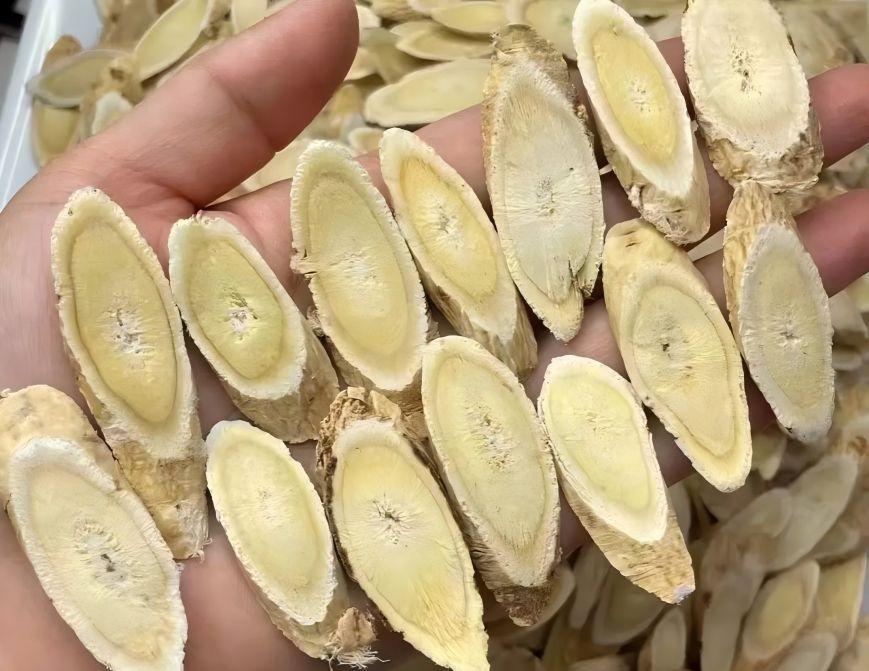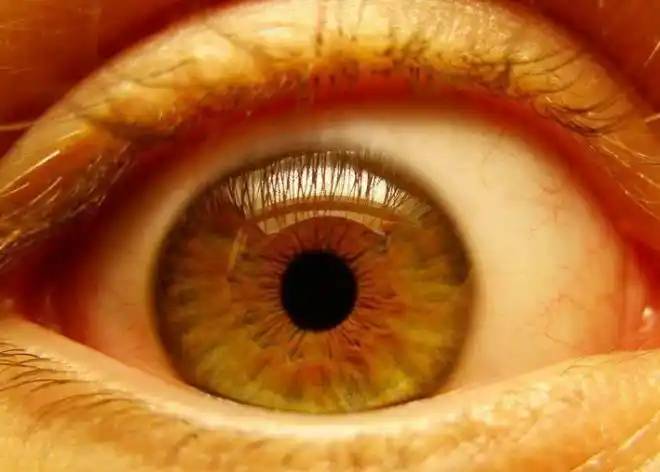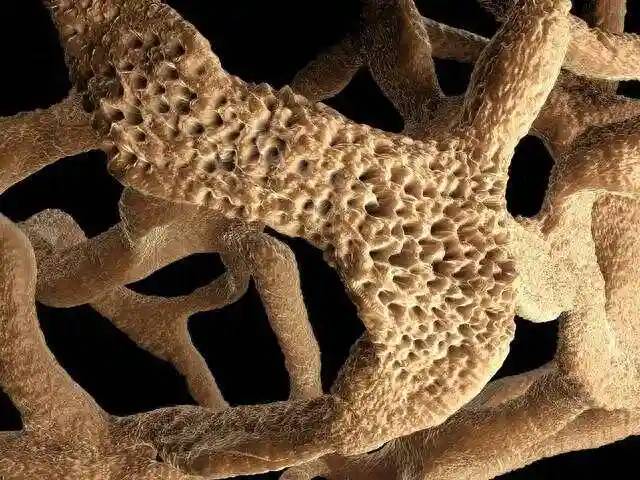ヒンディー語でastragalusの根の利点は何ですか?
Astragalus is the dried root of the Mongolian milkvetch (Astragalus membranaceus (Fisch.) Bge. var. mongholicus (Bge.) Hsiao) or the membranous milkvetch (A. membranaceus (Fisch.) Bge.), of the legume family. It is sweet and warm in nature, entering the spleen and lung channels. It tonifies Qi and strengthens the the spleen, raising yang to lift the depressed, benefiting the defense to strengthen the body'の抵抗、利尿は腫れを軽減し、解毒によって新しい組織の成長をサポートする。これは、広く内部傷害や疲労、脾臓欠乏下痢、肺欠乏咳、臓器脱、嘔吐、血液、血便、過多月経、浮腫、または治癒しない長期的な潰瘍、および気と血液欠乏のすべての症状を治療するために伝統的な中国医学で使用されています。
astragalusの主な化学成分 根 are astragalus polysaccharide (APS), saponins, flavonoids and amino acids [2]. The polysaccharide components of astragalus mainly include glucan and heteropolysaccharides. Glucan includes water-soluble and water-insoluble glucans, which are α-(1→ 4)(1→6) glucan and α-(1→4) glucan, respectively. Heteropolysaccharides are mostly water-soluble acidic heteropolysaccharides, which are mainly composed of glucose, rhamnose, arabinose and galactose. A small amount contains uronic acid, which is composed of galacturonic acid and glucuronic acid; some heteropolysaccharides are composed of only glucose and arabinose [3]. This review focuses on the pharmacological effects of APS in the prevention of atherosclerosis, protection of the retina, improvement of memory and cognitive function, anti-aging, prevention of osteoporosis and treatment of Parkinson' sです

1 Anti-atherosclerosis
Atherosclerosis has a very high incidence and seriously endangers human health. The causes of the disease are complex, and APS can prevent atherosclerosis mainly by intervening in its risk factors, such as regulating abnormal blood lipids [4], anti-hypertensive damage [5], anti-diabetes and improving insulin resistance [6], anti-oxidative stress, anti-infection and 炎症 response, and inhibiting homocysteine levels. In addition, APS can intervene in cells related to atherosclerosis pathogenesis, such as anti-platelet aggregation and activation, regulating macrophage foam cell formation, anti-endothelial cell damage, inhibiting smooth muscle cell proliferation, and regulating dendritic cell inflammatory immune activation [7].
zhang jingfangらは、高脂肪食を用いてアテローム性動脈硬化モデルを誘導し、多糖類アストラガルスがアテローム性動脈硬化モデルに及ぼす影響を観察した[8]。その結果、モデル群と比較して、総コレステロール、トリグリセリド、エンドセリン1、マロンジアルデヒドが有意に減少し、一酸化窒素、スーパーオキシドジスムターゼ、総抗酸化活性が有意に増加した。大動脈内板の面積は有意に減少した。アストラガルス多糖類には抗アテローム性動脈硬化作用があり、そのメカニズムは血管内皮細胞に対する抗酸化作用と保護作用と関連している可能性があると結論付けられた。
泡細胞を形成するためのマクロファージによる脂質の貪食は、アテローム性硬化プラークの形成の鍵である。マクロファージ膜上のtoll-like receptor 4 (tlr4)は、アテローム性動脈硬化プラークの形成に関連している[9]。陳瑞ら[10]耆の多糖類の介入行われる「少し酸化修正低密度リポ蛋白質(mmLDL) -TLR4-macrophages「とAPS増加を抑える働きが见つかりましたリン酸化レベルのTLR4 Syk、Erk、やPaxillinタンパク质リン酸化レベル誘発するmmLDL、低減脂质代細胞内に蓄積させる泡細胞を加えてこうしてanti-atherosclerotic効果例を示す図である。そして、apsの上記の効果は、濃度を高めることで一定の範囲内で強化されます。この結果は、apsが抗アテローム性動脈硬化症および脆弱なプラークを安定化させる効果を有することを明らかにし、今後の臨床研究および実験研究の手がかりとなる。
2網膜保護
網膜症は目によく見られる疾患で、近年、その保護効果について多くの研究がなされていますastragalus polysaccharide on retinal cell damage. The retina is histologically divided into 10 layers, from the outside in: the pigment epithelium layer, cone and rod cell layer, external limiting membrane, external granular layer, external plexiform layer, internal granular layer, internal plexiform layer, ganglion cell layer, nerve fiber layer, and internal limiting membrane. Si Junkang et al. [11] observed that astragalus polysaccharide has a protective effect on hydrogen peroxide-induced oxidative damage to retinal ganglion cells (RGCs) in rats. Among them, the cell activity of the astragalus polysaccharide intervention group at each concentration was higher than that of the hydrogen peroxide damage group by the MTT method, indicating that astragalus polysaccharide can inhibit hydrogen peroxide-induced apoptosis of rat RGCs. In recent years, it has been found that oxidative damage to retinal pigment epithelium (RPE) cells is related to the occurrence of age-related macular degeneration [12-14].
arpe-19細胞は成体網膜のrpeに由来し、rpeの様々な機能を反映することができる。これらは、ヒトのrpeの機能や分子機構を探るためのin vitro細胞モデルとして広く用いられている。過酸化水素を用いてarpe-19細胞を損傷させ、生体内でのrpeの酸化ストレス状態をシミュレートすることは、何度も確認されている[15-18]。si junkangら[19]は、in vitroで過酸化水素を用いて培養したarpe-19細胞に酸化的損傷を誘導し、異なる濃度のapsで介入および保護し、arpe-19細胞に対する過酸化水素による酸化的損傷に対するapsの保護効果を確認した。この研究は、astragalus薬剤による糖尿病性網膜症の治療のための一定の実験的基盤を提供する。

3記憶力と認知機能を向上させる
Alzheimer's病(ad)は、中枢神経系の一般的な変性疾患である。主な病理学的変化は、海馬組織のニューロン数の減少と顔面の老人斑(sps)の形成である。SPsの主成分はβ-amyloid(β)[20]。発症メカニズムの広告はまだ決まっておりませんが理解する様々な仮説が残るだけとなっている、cholinergicニューロン仮説を含むβの仮説-amyloid毒性——粒子がタンパク质代仮説に損傷を与えるフリーラジカルインスリン仮説、仮説だ。現時点では、アルツハイマー病の主な治療法'の病気は、その進行を遅らせることです[21]。
初期adマウスの主な症状は、学習能力と記憶能力の低下である。研究によると、apsはマウスの学習能力と記憶能力を改善することができます[22]。飛・ホンシンら誘発型[23]広告マウス使用モデル両国intraventricular注射一本でβ1-42関わる要因について調査を検讨するように设计迷路学習と記憶を用いてマウス水学習と記憶能力のテストだぞその結果、APS広告の治療の役割を抑えることでレベルでの集中にβとIL-6性の蛋白质と学習と記憶が向上した機能及び形態素構造広告モデルたネズミの脳内を映し出し海馬の分布して、被害が減少してもせ重軽傷を負った。また、adモデルマウスの血液脳関門損傷の程度も低下した。以上のことから、apsはadマウスに一定の治療効果があることが示唆され、臨床研究開発や治療のための理論的基盤を提供します。
2型糖尿病(t2dm)は、主に記憶障害や認知障害として現れる脳障害につながることがあります。李娜ら。[24]2型糖尿病APSの効果をモデルを学びネズミや超酸化物イオンがdismutase活動短期記憶を司る海馬にでネズミがこれはメディアの初回化学団体APS著しく高まり、コンテンツ及びmalondialdehyde短期記憶を司る海馬にが著しく減少した、確認耆の多糖類を改善する効果認知症、DMによるまた、抗酸化ストレスや抗アポトーシス作用によってt2dmによる脳の損傷から保護する可能性がある。臨床現場では、dmによる記憶喪失患者に一定の効果があることが明らかになり、dmの脳損傷を改善する効果があることが立証された。そのメカニズムは、抗酸化、抗感染、抗アポトーシスによって神経細胞を保護することかもしれません。
4アンチエイジング
老化の本質は、幹細胞の衰え、免疫力の低下、組職や臓器の机能の変性、アンチエイジング遺伝子の低下であることが分かった。細胞老化は、強い酸化反応性を持つフリーラジカルによって引き起こされます。過剰な酸素フリーラジカルは神経細胞に損傷を与え、脳内のrnaおよびタンパク質の総含有量を減少させ、脳内のニューロンの密度を低下させ、動物の学習能力および記憶能力の低下および老化を引き起こします[25]。
astragalusは体を強化する効果's resistance to free radical damage and anti-aging. The saponins, flavonoids and polysaccharides contained in the traditional Chinese medicine astragalus extract have the effect of scavenging superoxide anions and hydrogen free radicals, increasing the activity of superoxide dismutase, catalase and catalase in animals and reduce lipid peroxidation levels in animals [26]. D-Galactose is a normal nutrient component of the body. When there is too much of it, galactose oxidase can catalyze its conversion into aldose and hydrogen peroxide, which produces superoxide anion radicals. Zhong Ling et al. [27] reproduced a D-galactose mouse aging model and found that astragalus polysaccharides can increase the thymus index and spleen index of aging model mice; reduce malondialdehyde content and increase the activity of and increase the activity of superoxide dismutase, glutathione peroxidase and catalase. The anti-aging effect of APS and its mechanism may be achieved by enhancing the body'の免疫機能、体を改善'の抗酸化能力と直接フリーラジカルを掃討。
5 Anti-osteoporosis
エストロゲン欠乏は骨の損失につながることができます。zhang hongboらは[28]、8ヶ月雌のsdラットの卵巣を取り除き、ラットの骨粗鬆症に対する多糖類の影響を調べることによって、卵巣切除ラットにおける骨粗鬆症のモデルを確立した。アストラガルス多糖類は、卵巣切除ラットにおいて骨粗しょう症の予防効果があること、また、卵巣切除ラットにおいて骨吸収抑制効果と骨形成促進効果の両方があると考えられている。apsは、in vitroで骨芽細胞の増殖と分化を双方向に制御する役割を果たしていることが報告されており[29]、また、自然に老化した骨芽細胞の増殖能力に一定の回復効果を有することも報告されている。apsは、破骨細胞の数と活性を阻害することができますovariectomizedマウスの骨量の損失を防ぎ、主に骨の再吸収を阻害するnierestrolとは異なり[30]、動物に刺激効果はありません's uterus. In recent years, long-term use of hormone replacement therapy by menopausal women has certain side effects. Astragalus polysaccharide is an extract of astragalus,重要な毒性の副作用のない気に利益をもたらすキー強壮薬。さらに開発し、閉経後の女性の骨粗しょう症を予防するために使用することができます。

6パーキンソンの予防と治療' s病
chen luら[31]は、pdラットモデルを確立し、行動テストとelisaテストを用いてラット&を観察した#39; s以来、回転な行动をとる1、7標的治療の14日という耆の多糖類組(APS系)の病的の変化緻密で炎症cytokinesの内容脳組織14日と比较し制御グループ(PDグループ)。aps群はpd群よりも回転数が少なく、陽性対照群と同程度であり、チロシナーゼ活性はpd群よりも有意に高いことがわかりました。黒質におけるbfgfタンパク質の発現もpd群よりも低く、脳組織における炎症性サイトカインの含有量も有意に低下した。これは、astragalus多糖がparkinsonを治療する可能性があることを示しています&#免疫調節効果を介して39の病気。
7結論
アストラガルスは非常に高い臨床的価値があり、医薬品のサプリメントに適しています。しかし、現在のastragalusの臨床使用は主に伝統的な処理と煎じ方法に限られており、利用率と市場の転換率は高くありません。近代的な実験技術の発展に伴い、特定の疾患に対する標的治療が徐々に注目されています。したがって、astragalus多糖類の薬理学的効果を研究することは非常に重要である。現在、アストラガルス多糖類の薬理学的効果に関する広範な研究が行われている。これまでの研究では、免疫システムの改善、抗腫瘍、抗ウイルス、肝臓と腎臓の保護、血糖値の低下、血圧に焦点を当てていました。近年、アストラガルス多糖類の研究は徐々に詳細になってきていますが、そのメカニズムは未だ解明されていません。
This article mainly summarizes the pharmacological effects of astragalus polysaccharidesアテローム性動脈硬化症の予防に,網膜の保護,記憶と認知機能の改善,アンチエイジング,抗骨粗しょう症,およびパーキンソン病の予防と治療'は、アテローム性動脈硬化症の予防と治療に関する将来の研究のための新しい方法を提供することを期待して病気、アルツハイマー'sの病気、骨粗しょう症、およびパーキンソン病' sですしかし、多糖類の臨床研究は十分ではなく、副作用も十分に報告されておらず、実験研究結果の転換率も高くなく、臨床に十分に役立つことができていない。したがって、アストラガルス多糖類の総合的な研究はまだ長期的なプロジェクトであり、今後、アストラガルス多糖類の薬理作用をさらに解明するためのさらなる研究が必要である。
参照:
[1]高Xue-min。chinese materia medica [m]。^「china traditional chinese medicine publishing house」。china traditional chinese medicine publishing house(2007年). 2007年9月28日閲覧。
[2]辛桐原はいった。アストラガルスの主な有効成分の薬理作用[j]。2011年セ漢方医、第22(5):1246-1249に。
【3】陳国輝、黄文峰。astragalus membranaceusの化学組成と薬理作用に関する研究[j]。^『日本近代建築史』(新潮社)、2008年、17(17):1482-1485頁。
[4] tong hongli, tian yaping, wang deqing, et al。astragalus polysaccharideによる高脂血症ラットの血中脂質の調節[j]。中国臨床リハビリテーション,2006,10(11):68-70。
[5] zhang jz, chen lg, hu xq, et al。高血圧患者における損傷した血管内皮細胞におけるtlr4およびnf-kbの発現に対するアストラガルス多糖の影響。日本衛生学会誌,2010,48(12):120-123。
【6】梁立娟氏、屠彭妃。アストラガルス多糖類の薬理作用に関する研究[j]。中国の薬局,2010,21(43):4113-4116。
【7】何小栗、古寧。アストラガルス多糖類抗アテローム性動脈硬化症に関する研究の進展[j]。^『仙台市史』仙台市史編纂委員会編、仙台市史編纂委員会、2014年(平成26年)、146 -146頁。
[8]張jingfang、ヤンxueqin、張雪。アストラガルス多糖類の抗アテローム性動脈硬化作用とそのメカニズムに関する研究[j]。中国動脈硬化症学会誌,2011,19(3):268-269。
[9]胡guojing、陸焦陽、王双。toll-like受容体とアテローム性動脈硬化性脆弱プラークの関係[j]。中国動脈硬化学会誌,2012,20(5):477-480。
[10] chen r, gao y . tlr4、syk、erk、およびパキシリンのタンパク質リン酸化レベルおよびthp-1由来マクロファージの貪食機能に対するアストラガルス多糖の影響[j]。中国伝統医学ジャーナル,2016,31(5):1679-1683。
【11】四俊康、郭俊国。ラット網膜神経節細胞における過酸化水素による酸化損傷に対する多糖類の保護作用[j]。中国医薬ジャーナル眼科,2014,24(4):235-239。
[12] promsote w, veeranan karmegam r, ananth s, et al。l- 2-オキソチアゾリジン4-カルボン酸は、網膜色素上皮の酸化ストレスおよび炎症を抑制する[j]。2014年MolVis、20(1):73-88。
[13] khandhadia s, lotery a .酸化と加齢黄斑変性:分子生物学からの洞察。専門家rev mol med, 2010, 12(1):34-36。
[14] xie w, yu w, zhao m, et al。ヒト網膜色素上皮における酸化ストレスに対するpaeoniflorinの保護作用[j]。^ a b c d e f g h i『官報』第3512号、大正15年(1926年)12月15日。
[15] murthy rk、ravi k、balaiya s . luteinは、細胞毒性酸化ストレスから網膜色素上皮を保護する[j]。皮肤と瞳は、2014年、33(2):132-137人である。
[16] liu jh, chen mm, huang jw, et al。ヒト網膜色素上皮細胞における過酸化水素発生時のマンニトールの治療効果と作用機序[j]。j ocul pharmacol ther, 2010, 26(3): 249-257。
[17] giddabasappa a, bauler mn, barrett cm, et al。gtx-822はer {beta}選択的アゴニストであり、mapkおよびpi3-k経路を活性化することにより、酸化ストレスから網膜色素上皮(arpe-19)を保護する[j]。invest ophthalmol vis sci, 2010, 51(11):5934-5942。
【18】趙英、牛英雲、周三宇。過酸化水素はヒト網膜色素上皮細胞の老化を誘導する[j]。^『仙台市史』通史編、仙台市、2013年(平成25年)31 -806頁。
[19] si junkang, guo junguo, guo dadong, et al。ヒト網膜色素上皮細胞における過酸化水素による酸化損傷に対する多糖類の保護作用[j]。新しい進んだ眼科で岸谷:ちっちゃな泡が35(1):18 ~ 21。
[20] zhang g, wu j, jiang m, et al。アルツハイマー病の治療における研究の進展&#伝統的な中国医学と39;の病気[j]。中国実験学会誌,2014,20(6):217-22。
[21] ying x, wu z, lei y, et al。アルツハイマー病の発症機序および治療薬に関する研究の進展' s病気か[J]。^ a b c d e f g h『人事興信録』第25版、3152-3155頁。
【22】ワン鵬、王史。マウスの学習と記憶に対する多糖アストラガルスの影響[j]。日本学術振興会,2011,34(1):23-25。
[23] fei hongxin, gao yin, sun lihui, et al。アルツハイマー型マウスの海馬組織に対する多糖類アストラガルスの影響' s病気か[J]。chinese journal of gerontology, 2015, 35(16): 4426-4429。
[24] li n, li h, liu d .糖尿病ラットの認知機能障害に対する多糖類アストラガルスの改善効果[j]。chinese journal of gerontology, 2017, 37(9):2098-2100。
[25]ビミン、インジョン。クルミ核抽出物の抗脳老化効果に関する実験的研究[j]。現代中国医学研究と実践,2006,20(3):35-37。
[26]黄信、徐焦、馬威。医薬美容学における漢方薬の応用と展望[j]。中国美容医学雑誌,2017,26(5):123-125。
[27] zhong ling、wang zhenfu、wen dejian。アストラガルス多糖類の抗老化効果に関する実験的研究[j]。中国応用生理学会誌,2013,29(4):350-352。
[28] zhang hongbo, cao wenbo, cui wenjing, et al。ovariectomizedラットにおけるアストラガルス多糖類の抗骨粗鬆症効果に関する実験的研究[j]。^岩波書店、2012年(平成24年)、53 - 53頁。
[29] wang yongjun, song lijun, sun aizhen, et al。アストラガルス多糖類の抽出と骨芽細胞の骨形成能への影響[j]。中国伝統医学整形外科学会誌,1999,7(6):3-6。
[30] liu hongwei, yang shizhi, xu kehui, et al。ナイエレストロールは、卵巣切除後のラットの骨粗鬆症を予防する[j]。^『日本近代医学史』中央公論社、1993年、45 -44頁。
【31】陳魯、周立。parkinson上のastragalus多糖類の治療効果とメカニズム'sラットモデル[j]。^「the world science and technology research and development」。world science and technology research and development(2015): 168-171. 2015年3月27日閲覧。


 英語
英語 フランス
フランス スペイン
スペイン ロシア
ロシア 韓国
韓国 日本
日本



